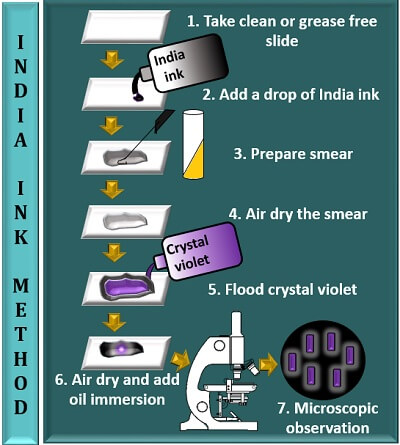Procedure Place a drop of India ink onto a clean glass slide Using a sterile loop obtain a sample and place it onto the. Put a small drop of a negative stain on the slide.
Since the capsule is.

. It can define as the polysaccharide envelope which surrounds the cell wall. In the circle below draw a representative portion of your slide. Prepare a smear of bacteria in nigrosin as described in the procedure for a negative stain.
You just studied 6 terms. The capsule stain uses two reagents. Procedure of Capsule Staining.
Hold the slide with a wooden clothes pin approximately 1cm over the barrel of a hot incinerator for 20-30 seconds Let the slide cool. Besides that a 20 solution of copper sulfate is used which plays an important role in staining procedure by acting as a decolorizing agent as well as Counterstain. India Ink Method Cont.
Gram staining procedure uses different chemicals and dyes that can be grouped. Aseptically add a loopful of bacterial culture to drop and mix it properly. Capsule staining procedure involves identification of capsular material.
With another slide drag the ink-cell mixture into a thin film along with the first slide and leave for 5-7 minutes for air drying avoid heat fixing. For this reason it becomes necessary to stain the background using. 1 aqueous solution of Crystal Violet is used as primary stain.
Methods for Capsule Staining India ink method Anthonys stain method 6. Experimental learning objectives 100 Use the reagents in the correct order for capsular staining 100 Leave the reagents on the slide for the right amount of time 100 Blot the slide dry before using the microscope 100 Determine the success of your capsule staining technique 100 Post-lab Questions 100 Identify correctly and incorrectly. This one is another most commonly used method of Capsule staining.
It is applied to a nonheat-fixed smear. Procedure of Endospore Staining. Gram stain is a very important differential staining technique used in the initial characterization and classification of bacteria in microbiology.
In the capsule staining method copper sulfate is used as a decolorizing agent rather than water. In the capsule staining 20 Copper Sulfate 20 is used as a decolorizing agent rather than water. A capsule being non-ionic will not stain by either of the two dyes.
Capsule performs many functions like cell protection. Both the cell and the capsular material will take on the dark color. Saturate the blotting paper with malachite green stain solution and steam for 5 minutes keeping the paper moist.
A capsule is a gelatinous outer layer that surrounds and adheres to the cell wall and is secreted by bacterial cells. India Ink Method Requirements India ink Crystal violet Glass slide Inoculating loop 7. Capsule staining uses two reagents.
Biology questions and answers. The copper sulfate washes the purple primary stain out of the capsular material without removing the stain bound to the cell wall. Gram staining helps to identify bacterial pathogens in specimens and cultures by their Gram reaction Gram-positive and Gram-negative and morphology coccirod.
The majority of capsules are made of polysaccharides but some are made of polypeptides. The primary function of capsule staining procedure is to differentiate capsular material from bacterial cells. Take a clean grease free slide and make smear using sterile technique.
It is also known as hexamethyl pararosaniline chloride or methyl violet 10B or gentian violet. Do not hear or blot dry After allowing the spread smear to air dry cover it with safranin or crystal violet for about a minute. Explain the role of.
The Gram stain is a differential method of staining used to assign bacteria to one of two groups gram-positive and gram-negative based on the properties of their cell wallsIt is also known as Gram staining or Grams method. Gram Stain Reagents. It differentiates the capsule from the rest of the cell body.
Describe the role of following reagents using capsule staining procedure. Here its worth noting that for most part capsules are non-ionic. The other approach of capsule.
The principle of capsule staining is based on staining of background with an acidic stain and staining of bacterial cell with a basic stain. Describe the role of following reagents using capsule staining procedure. Copper Sulfate 20 The capsule is non-ionic but the bacterial cell wall is anionic.
It includes capsule endospore and flagella staining. Primary Stain Crystal Violet It is an intensely purple-colored organic compound chemically called triphenylmethane dye. Hold the slide with a wooden clothes pin and pass 10-12 times through the flame.
Its color depends on the. The procedure is named for the person who developed the technique Danish bacteriologist Hans Christian Gram. Thus capsule staining creates contrast by staining a bacterial cell along with its background and leaving a capsule as a colourless halo.
Crystal Violet 1 aqueous A primary stain crystal violet is applied to a non-heat-fixed smear. Air dry and heat fix the organism on a glass slide and cover with a square of blotting paper or toweling cut to fit the slide. Label the capsule bacterial cell and negative stain 1.
Explain the role of the reagents used in the capsule stain. Primary stain and the counterstain. The cell and the capsular material both will take the violet color at this point.
As a result acidic and basic stains will often fail to adhere on to them. This is carried out by the use of both positive and negative dyes. In this technique the crystal violet stain is used as the primary stain.
Capsule stain is a type of differential stain which involves the use of two stains.

Capsule Stain Principle Procedure Results Microbe Online

What Is Capsule Staining Definition Principle Methods Biology Reader


0 Comments